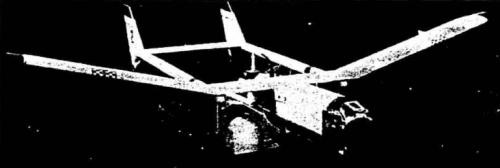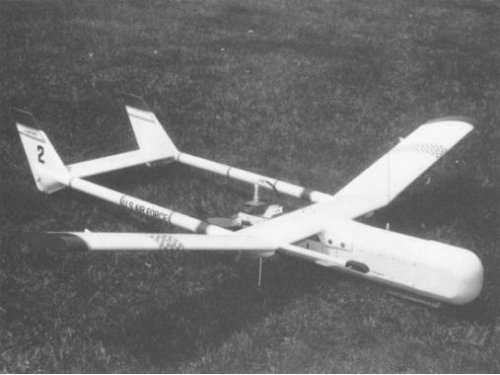- Joined
- 27 April 2008
- Messages
- 406
- Reaction score
- 126
AXILLARY was an E-Systems E-45 UAV studied in the 70's under the RPAODS program.
The previously redacted (until 2013) http://nsarchive.gwu.edu/NSAEBB/NSAEBB434/docs/U2 - Appendices-Bibliography.pdf' Appendix E of http://www.foia.cia.gov/sites/default/files/document_conversions/2/DOC_0000190094.pdf The Central Intelligence Agency and Overhead Reconnaissance: The U-2 and OXCART Programs, 1954—1974 says this about it:
It is also mentioned in 'To Boldly Go Where No Unmanned Aircraft Has Gone Before: A Half-Century of DARPA’s Contributions to Unmanned Aircraft' http://www.enu.kz/repository/2010/AIAA-2010-158.pdf
Finally, there is a small reference concerning it in 'Air Force UAV's: A Secret History' http://dtic.mil/cgi-bin/GetTRDoc?AD=ADA525674
The previously redacted (until 2013) http://nsarchive.gwu.edu/NSAEBB/NSAEBB434/docs/U2 - Appendices-Bibliography.pdf' Appendix E of http://www.foia.cia.gov/sites/default/files/document_conversions/2/DOC_0000190094.pdf The Central Intelligence Agency and Overhead Reconnaissance: The U-2 and OXCART Programs, 1954—1974 says this about it:
While Project AQUILINE was still under development, its chief aero-dynamicist, Charles N. Adkins, left the program because he believed that its escalating costs would prevent it from ever producing a de-ployable aircraft. He wanted to build a small. inexpensive remote-controlled aircraft to test a low-cost lightweight autopilot currently being developed by ORO. Under a $5,000 time-and-materials contract with Melpar Incorporated. Adkins hired a local model aircraft builder to assemble and modify a standard Hawk-750 glider kit and power it with a rear-mounted engine and pusher propeller. Following a series of successful test flights, Adkins installed a small camera and took a number of aerial photographs. By this time the effort to build a "Miniature Multi-Purpose Airborne Vehicle" had become known as Project AXILLARY. Melpar, Inc. received a second contract for $50,000 to install ORO's autopilot in the aircraft, and the project managers now began searching for a use for their vehicle. The two main possibilites were (1) as a short-range reconnaissance vehicle for use in a peace-monitoring or intelligence-gathering system and (2) as a short-range warhead delivery system. In 1971 the Office of Special Activities evaluated AXILLARY flight-testing and determined that the small model air-craft was not suitable for use as a covert reconnaissance vehicle because of its large radar cross section and significant accoustical signature. The aircraft's radar signature made it potentially useful as a weapons system, however. ORD suggested that AXILLARY be equipped with a radar-homing unit [REDACTED] which would make it an inexpensive means for [REDACTED] surface-to-air missile systems in North Vietnam.
It is also mentioned in 'To Boldly Go Where No Unmanned Aircraft Has Gone Before: A Half-Century of DARPA’s Contributions to Unmanned Aircraft' http://www.enu.kz/repository/2010/AIAA-2010-158.pdf
...a joint DARPA/Air Force/Army study during the early 1970s called the Remotely Piloted Aerial Observation Designation System (RPAODS). Another RPV program under this effort was Axillary (Latin, “relating to the feathers under a bird’s shoulders”), which developed the E-Systems E-45 expendable mini-RPV capable of loitering and attack. The E-45 was intended to be a multi-purpose testbed with a gross weight of 45 lb. It was a highwing monoplane with twin tailbooms and was powered by a rear-mounted 2 hp single-cylinder two-stroke engine powering a pusher propeller. The wingspan was 7.9 ft and overall length was 7.8 ft; the cruise speed was 43 kt and endurance was 5 hours. The main sensor was a gimbal-mounted miniature TV camera.3 A total of twelve E-45s were built and first flew in June 1974. Radar homing tests were also conducted; with a small explosive charge, they could have been used for suppression of enemy air defenses (SEAD). Some aircraft were upgraded to the E-55 standard, with a 3.7 hp Toper single-cylinder engine. This increased the maximum gross weight to 55 lb and speed to 52 kt, but reduced the endurance to 4 hours. This also doubled the payload from 15 lb to 30 lb.
Finally, there is a small reference concerning it in 'Air Force UAV's: A Secret History' http://dtic.mil/cgi-bin/GetTRDoc?AD=ADA525674
RPAODS competitors were Melpar’s E-35 (the RPV version of Melpar’s Axillary radar-homing drone) and the Philco-Ford Praeire II. US Army “RPV Briefing to Maj. Gen. McAuliff (U),” May 1974 (Sherwin Arculis personal files)
Attachments
Last edited by a moderator:


